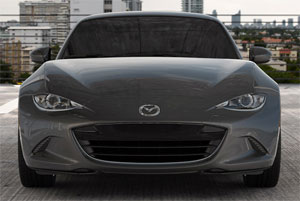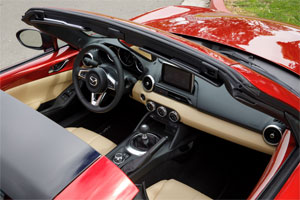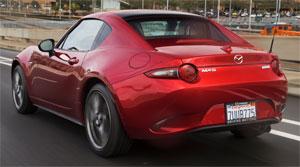2017 Mazda MX-5 Miata RF
There’s a new Mazda Miata in town, and it’s more than just a hardtop, it’s something entirely different. It’s the MX-5 RF, for retractable fastback. Now is it just a Miata that’s better in bad weather, or is it a better Miata period? Well, we feel it’s our duty to get to the top of it!
Sports cars have been in a bit of a slump lately, though the Mazda MX-5 Miata has mostly been immune. But just to ensure the excitement meter stays pegged; for 2017, Mazda has something special for all of us, this Miata RF.
Much different than the previous gen’s Power Retractable Hard Top, this Retractable Fastback features a somewhat complicated design that somehow works very smoothly, and stores the center section of the roof only, in the same amount of space as the soft top, leaving trunk capacity exactly the same. You could call it a Targa, but Mazda chose not to.
 It’s much better in every way than the previous hard top. And as sharp as it looks with it up, we can see a lot of style-conscious fans buying it for that reason alone.
It’s much better in every way than the previous hard top. And as sharp as it looks with it up, we can see a lot of style-conscious fans buying it for that reason alone.
The RF also includes some additional sound-deadening material, so engine and tire noise are more tempered, a plus if you’re planning longer trips.
The RF looks much different in profile of course, unique enough that it wasn’t instantly recognizable as a Miata to many we encountered.
The RF weighs about 110-lbs more than the roadster, but you won’t notice it in around town driving.
And we love that everything remains super simple inside. All is right where you expect it to be, including the shifter for the standard 6-speed manual.
But that also means frustrating cup holders and minimal small item storage space.
 No other changes inside, save for the button to set the top in motion and a new TFT screen in the gauges that will make its way into other Miatas soon.
No other changes inside, save for the button to set the top in motion and a new TFT screen in the gauges that will make its way into other Miatas soon.
Plenty of headroom remains, but if our RF had any downside, it was wind noise. Too much of it made it inside, seemingly right by our ears.
Nothing deviates from the norm in the powertrain department. Under-hood lies a SKACTIV-G 2.0-liter I4 with 155-horsepower and 148 lb-ft. of torque.
Maybe it was the top’s added weight, or test day’s hot temps, but our RF manual was a few tenths slower to 60 than the last cloth top we tested, at 6.3-seconds.
Only moderate throttle modulation is necessary at launch, as there’s not enough torque to really cause problems. Both clutch and shifter work as precisely as always, allowing you to move quickly through the gears. We finished the ¼-mile in 15.0-seconds flat at 92 miles-per-hour.
 And without a doubt, no matter what is or isn’t over your head, the MX-5 remains a great place to take in the blurry sights surrounding your favorite back road. Or our choice, the curves of Northern Virginia’s Dominion Raceway.
And without a doubt, no matter what is or isn’t over your head, the MX-5 remains a great place to take in the blurry sights surrounding your favorite back road. Or our choice, the curves of Northern Virginia’s Dominion Raceway.
We know that a hardtop can add some rigidity to a car’s chassis, but to be honest we didn’t sense that either, as the basic car is now so solid.
Both the suspension and electric power steering have been recalibrated, and if anything, we noticed a little less feel through the wheel than before, though reaction is still very quick. Throttle response also felt a little deadened.
The RF is only available in Club and Grand Touring trim, with base pricing that works out to be around 3-grand extra. So, its $32,430 for the Club RF, and $33,495 for the Grand Touring.
So, you have to really love the new look. Now, we view the MX-5 as the best bargain among sports cars, so we’d probably stick with the original and spend the money we saved on performance upgrades.
Still, one thing is clear. Mazda took great strides to give buyers not just a hard top version of our beloved Miata, but something that is truly different. The 2017 MX-5 Miata RF is a uniquely charming take on the minimalist roadster theme; and a beauty not just for our eyes, but for all of our senses.
Specifications
- Engine: 2.0 liter
- Horsepower: 155
- Torque: 148 lb-ft.
- 0-60 mph: 6.3 seconds
- 1/4 mile: 15.0 seconds @ 92 mph
2025 Volkswagen ID. Buzz
Volkswagen Brings Beetlemania Level Of Excitement To Minivan Segment
The duty of upholding Volkswagen’s heritage has most recently been delegated to small legacy car names like Golf and Jetta. But hold on! A much larger, totally modern take on VW’s classic microbus has just buzzed over the horizon— the all-electric ID. Buzz. It’s been at the top of our minds since we first saw the concept back in 2017. Well, it’s finally here, so let’s get our groove into drive!
This 2025 Volkswagen ID. Buzz has indeed created the most buzz around Volkswagen since the Beetle’s return to the U.S. in the late 1990s. We couldn’t drive it anywhere without drawing a crowd. No wonder, just about everyone has a VW Microbus story to tell, and seeing this reimagined version rolling down the street brings back all those memories.
VW really pulled it off as far as we’re concerned, as it looks great without appearing over the top. All the cues are here: Big VW logo front and center, lots of greenhouse including A-pillar windows and mini sliders for the second-row passengers, D-pillar air vents, and two-tone wheels. And while its appearance may be pure retro, its drivetrain is far from it, as the ID. Buzz is all-electric, and unlike the new Beetle, the Buzz does retain the original Microbus’ rear-drive architecture.
Powering those rear wheels is a 210-kW motor drawing juice from a 91-kWh battery for a range of 234 miles; 200-kW max charging will get you to 80% in about 26 minutes. Buyers can add another small 80-kW motor up front for 4motion all-wheel-drive and an increase of total output from 282 to 335 horsepower with a combined 512 lb-ft of torque. It uses the same battery, but range estimates drop just slightly to 231 miles. But while those numbers are modest, we also found them to be quite conservative, as we observed as many as 287 miles available in our all-wheel-drive tester’s gauge display and were on pace for 273 miles in our driving loop.
One throwback theme that may be a turnoff to some is that it’s quite a step up into the Buzz’s front seats, but there’s certainly a commanding view of the road once you climb in. Second row seating can be either a three-place bench or a pair of captain’s chairs, so there’s generous room for seven or six passengers. The captain’s chairs in our Pro S Plus offer good support and very easy access to the third row.
Lots of flexibility too with the option to simply fold the seats or remove them altogether.
With the sliding side doors and a wide opening rear hatch, there’s plenty of access for loading big sport utility amounts of cargo. Lots of flexibility too with the option to simply fold the seats or remove them altogether, and the ability to create a full-length flat floor with a rear cargo shelf that covers some handy removable storage bins. There’s 18.6 cubic-feet of space behind the third row, 75.5 behind the second, and a max of 145.5. That’s more than a Chevrolet Tahoe. For smaller items, there are lots of cubbies throughout the cabin, along with a standard Buzz Box that can be moved to multiple locations.
With a design that prioritizes retro form and modern function over aero efficiency, the 4motion equipped ID. Buzz earns a Fair efficiency rating, using 42-kWh of electricity per 100 miles, and we weren’t sure what to expect at our Mason Dixon test track.
What we found was great torque off the line and drama free launches to 60 in just 5.3 seconds. It was very stable at speed and power delivery stayed steady most of the way down the track until we reached about 90 mph, when it began to taper off just before we finished the quarter-mile in 14.0 seconds flat at 97 mph.
With 1,200-lbs. of battery weight nestled in its 127.5-inch wheelbase, the Buzz felt planted to the pavement through our handling course. There was quite a bit of body roll to deal with, but surprisingly little understeer. In panic braking runs, pedal response was inconsistent, feeling soft at times, pushing back hard at others; but through it all, results were quite good, stopping from 60 in an average of just 108 feet.
Three interior themes are available, this Dune is the brightest, featuring coastal inspired wood optic dash décor, “gray and clay” leatherette surfaces, and a high-mounted central 12.9-inch touchscreen. Pricing starts with a rear-wheel-drive Pro S at $61,545; this Pro S Plus begins at $65,045, add another $4,500 for 4motion, which brings a few extra features along with all-wheel drive.
Retro design with old-school VW charm, modern EV drivetrain, big SUV capacity merged with minivan flexibility; it all comes together in this 2025 Volkswagen ID. Buzz. It’s easily one of the coolest rides of the year and one that will likely keep Volkswagen dealers buzzing for years to come, and that’s something no other people and things mover can say.
Specifications
As Tested
- Motor Setup: Dual-Motor AWD
- Battery Size: 91-kWh
- Horsepower: 335
- Torque: 512 lb-ft
- EPA Range: 231 miles
- 0-60 mph: 5.3 seconds
- 1/4 Mile: 14.0 seconds at 97 mph
- Braking, 60-0: 108 feet
- MW Test Loop: ~ 273 miles













































